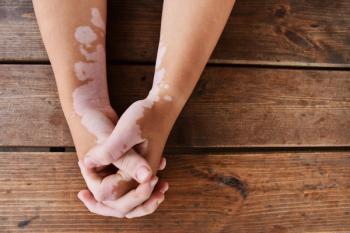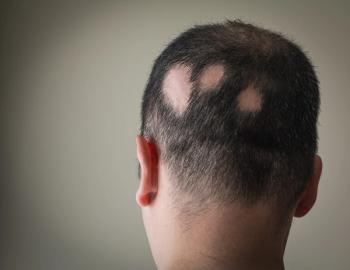
A Young Girl With Unexplained Cervical Lymphadenopathy: Infection? Lymphoma--or Something Else?
An 11-year-old African American girl was hospitalized with new fever in the context of unexplained cervical chain lymphadenopathy. WBC and ANC were low, ESR and LDH levels were elevated. Does the image here offer a clue to the ultimate diagnosis?
A previously healthy 11-year-old African American girl was hospitalized with new fever in the context of unexplained cervical chain lymphadenopathy. Six weeks before admission, a single left anterior cervical lymph node had become enlarged; this progressed to involve the entire left cervical chain. In the 3 weeks before admission, an outpatient workup revealed a worsening neutropenia, which was presumed to be secondary to a viral infection. Fatigue and malaise developed, and her pediatrician referred the girl to the emergency department (ED) when she became febrile (38.8°C [101.8°F]).
The patient had lost 6 lb over the previous 3 weeks. She also reported having a sore throat. Her family history was significant for eczema and her maternal grandmother had type 2 diabetes. The family had made a recent trip to a local farm.
On arrival at the ED, the patient’s temperature was 38.5°C (101.5°F). She had a mild erythematous rash on the extremities, tender left anterior cervical lymphadenopathy (LAD), and multiple non-tender, 1- to 2-cm, mobile lymph node enlargements, including the left supraclavicular node.
Laboratory tests revealed a low total WBC count of 1.83 K/µL (normal range 4.5-11 K/µL) with a low absolute neutrophil count of 0.77 K/ µL, hemoglobin of 11.2 g/dL, and platelet count of 159 K/µL. Other findings included 3% reactive lymphocytes, elevated ESR (24 mm/h), elevated lactate dehydrogenase (841 U/L; normal range, 50-200 U/L), and decreased uric acid level (2.5 mg/dL; normal range, 4.0-8.5 mg/dL).
Serology was negative for infection with hepatitis A, B, and C viruses, as well as HIV, cytomegalovirus, and human herpes virus-6. Titers for IgG antibodies to Parvovirus and Epstein-Barr virus were positive and negative for IgM antibodies. Borrelia burgdorferi, Histoplasma, Coccidiodes, Toxoplasma, Bartonella, and Aspergillus serologies also were negative. Blood cultures did not grow any organisms. Angiotensin-converting enzyme levels were normal, and results of a rapid plasma reagin test were negative.
A bone marrow aspirate revealed 20% cellular marrow with trilineage hematopoiesis and mild marrow injury. An aspirate smear showed hemophagocytosis. Flow cytometry showed a left-shifted myelopoiesis with no blasts or acute leukemia identified. Triglycerides were within normal limits, and ferritin levels were elevated at 812 ng/mL (normal range, 15-200 ng/mL).
Results of an excisional biopsy of the left supraclavicular node were pending.
A titer for ANA was negative and rheumatoid factor level was within normal limits. Serum C3, C4, and total complement levels were within the normal range.
Chest films were negative. Findings of a CT scan of the chest, abdomen, and pelvis were normal except for sub-centimeter lymphadenopathy in the inguinal and axillary regions.
The differential diagnosis at this point included:
• Infectious lymphadenitis
• Lymphoma
• Hemophagocytic lymphohistiocytosis
• Autoimmune lymphoproliferative syndrome
• Systemic lupus erythematosus
• Rosai Dorfman disease
• Kikuchi-Fujimoto syndrome
What’s your diagnosis?
Answer: Kikuchi-Fujimoto Disease
Kikuchi-Fujimoto Disease (KFD), or histiocytic necrotizing lymphadenitis, is a benign, self-limited lymphadenopathy without a clear cause. It usually affects young women, frequently of Asian descent. KFD typically presents as a cervical lymphadenopathy with prolonged fever.
Most cases of KFD occur in Asia (a third occur in Taiwan). Women are affected twice as frequently as men. Common signs and symptoms include lymphadenopathy (100% of cases, most often cervical lymphadenopathy) and fever (35%): rash, fatigue, myalgias, and arthritis occur in fewer than 10% of cases. Common laboratory findings in patients with KFD include leukopenia, elevated ESR, anemia, and transaminitis.1,2
On hospital day 7, the patient underwent lymph node biopsy; results were preliminarily read as KFD and were subsequently confirmed by the National Institutes of Health. Figure 1 (low power) shows lymph node necrosis without neutrophils (histiocytes as predominant cell type); Figure 2 shows the biopsy sample on high power.
On day 9, her fevers had resolved and her ANC began to rise. She was discharged to home the following day (day 10). Follow-up appointments were scheduled with her primary care physician, rheumatology, and hematology. Caloric supplementation was continued at home and she and her parents were advised to maintain neutropenic precautions until normalization of her ANC could be confirmed. Additional tests to evaluate the patient for hemophagocytic lymphohistiocytosis (HLH) (NK function, perforin /granzyme B activity, sIL-2r level) were ordered before the lymph node biopsy; results were abnormal, but were not consistent with the diagnosis of HLH.
Figure 1.
Diagnosis
Definitive diagnosis is currently based on excisional biopsy of an affected lymph node with subsequent histologic evaluation.3 The classic pathologic findings in KFD include patchy subcortical necrosis with karyorrhectic debris and plasmacytoid dendritic cells, without neutrophil involvement. The use of fine needle aspiration and cytological techniques are still being evaluated, but the presence of reactive lymphoid cells with crescentic macrophages and extracellular apoptotic cell death without neutrophilic infiltrate or granulomata/giant cells is considered diagnostic.4
Figure 2.
Management
KFD usually resolves spontaneously within 1 to 4 months. Most patients respond well to NSAIDs; however those with prolonged or severe symptoms or with concomitant systemic lupus erythematosus or other autoimmune processes may respond well to glucocorticoids and/or hydroxychloroquine.5
Teaching Points:
• KFD is a benign form of lymphadenopathy that has been weakly associated with autoimmune and viral etiologies. It is often diagnosed only after exhaustive workup for malignant and infectious entities.
• While it remains prudent to rule out life-threatening diagnoses early in patients with concerning findings, a biopsy of the affected lymph node usually results in a definitive diagnosis. Therefore, excisional biopsy should be considered early in the course of the workup in patients with possible KFD.
• While rare, KFD should remain on in the differential during evaluating of a patient for an oncologic and infectious condition.
References:
References
1. Kucukardali Y, Solmazgul E, Kunter E, et al. Kikuchi-Fujimoto disease: analysis of 244 cases. Clin Rheumatol. 2007;26:50-54.
2. Baumgartner BJ, Helling ER. Kikuchi’s disease: a case report and review of the literature. Ear Nose Throat J. 2002;81:331-335.
3. Cunha B, Mickail N, Durie N, et al. Fever of unknown origin (FUO) caused by Kikuchi's disease mimicking lymphoma. Heart Lung. 2009;38:450-456.
4. Osborn M, Aqel N, Levine T. The fine needle aspiration appearances of Kikuchi's lymphadenitis. Cytopathology. 2009;20:36-43.
5. Chen P, Huang Y, Tang C, et al. Kikuchi-Fujimoto disease: an amazing response to hydroxychloroquine. Eur J Pediatr. 2010;168:1557-1559.
Newsletter
Access practical, evidence-based guidance to support better care for our youngest patients. Join our email list for the latest clinical updates.














